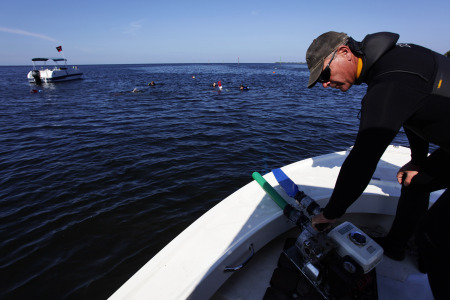
"I found something - it's old and it's metallic,'' said Allyn, wearing a wet suit and standing in chest-deep water off Bayport Park on Thursday morning.
Then, moments later, marine archaeologist Billy Morris surfaced with an update that topped Allen's.
"It's a piece of steam pipe,'' Morris said.
That pipe, about 9 inches in diameter and 2 feet long - definitely iron and definitely consistent with the side-wheeler the divers were looking for - is some of the most solid evidence ever found of a dramatic and often overlooked chapter in Hernando history.
During the Civil War, the Union naval blockade successfully sealed off major Southern ports such as New Orleans and Savannah. That forced blockade runners to use backwater harbors - or, as Bayport was at the time, wilderness outposts - to sneak goods in and out of Confederate territory.
Occasionally, such as during a skirmish off Bayport in April 1863 that killed at least one Confederate soldier and wounded several others, the South fought back, either from the water or the shore.
Five months later, a force of several Union ships led by Lt. Cmdr. A.A. Semmes was expecting more of the same when it lingered for a week off Bayport - hoping for a tide high enough to allow the steamer they had sighted to leave or for the ships to attack, said Nicole Tumbleson, outreach coordinator for the Florida Public Archaeological Network center in Crystal River.
But when the Union sailors finally did approach the port, on Sept. 19, they saw both the steamer and an onshore cotton warehouse go up in flames.
"I think as soon as the Confederates saw all those ships, they knew they were in trouble,'' Tumbleson said.
No doubt they also wanted to avoid turning over such a prized vessel.
While many of the blockade runners were homemade "vernacular'' boats barely large or sound enough to cross open water, Tumbleson said, the steamer was described by Semmes as about 200 feet long and, apparently, English-made.
It is also considered a major prize for archaeologists.
The site was discovered in 1991 by an amateur historian and diver named Matt Mattson, though neither he nor a state archaeologist who later explored the site were able to establish that they had found the wreck of the steamer.
Tumbleson returned to the site earlier this year as part of an ongoing project to document and map Civil War-era artifacts at Bayport, and used a metal detector to map out a field of metal debris about 70 feet long.
Last week, she and team of volunteer divers explored it for the first time, finding the pipe, pieces of machinery, iron hull plates, charred wood and ceramic fragments of a sink, as well as brass hinges that might have allowed the sink to be folded against the steamer's bulkhead when not in use.
And on Friday, a "good day,'' Morris said, "we finally figured out some of the wreck's structure. It appears the machinery that was up on the deck had fallen down into the hull.''
So how sure can they be that this is all from the scuttled steamer?
"How does 83 percent sure grab you? It's looking pretty good,'' said Morris, of St. Augustine, who previously studied the wreck of a famous Confederate sloop, the Alabama, near Cherbourg, France.
Of course, without paperwork or, say, a bell engraved with the name of the steamer, it's impossible to say for sure. And, because historians don't even know the ship's name, even the bell wouldn't cinch it, Morris said. "But it would be pretty ... cool to find.''
Even without it, the dive advanced all of the project's goals: filling in gaps in the history of Bayport, registering the port on a statewide list of historic sites and providing fodder for a volunteer group, Hernando Past, that wants to create a local trail of Civil War sites.
Tumbleson asked me, as archaeologists usually do, to be as vague as possible about the site's location, the idea being to throw looters off the trail. But considering that the divers were working so close to the pier that fishermen were practically looking over their shoulders, that didn't seem possible.
So, instead, let me pass on her request to anyone tempted to strap on tanks or even a mask and snorkel and disturb this wreck: Please don't.
You won't see much, for one thing. Most of the remains are covered with silt and oyster shells. And once you remove any individual piece from the wreck - a sliver of wood, a hunk of rusted iron - it becomes just that, a worthless scrap.
Only as part of the whole does it have value, which is why Tumbleson and her crew left most of what they found in place and returned the few items, such as the brass hinges, that needed to be photographed.
So, most of us will never see this wreck, just as most of us will never see a lot of endangered animals - and value them anyway.
The view from Bayport was always good. Knowing this wreck is there - near proof of an era of flames and gunfire and desperate commerce - makes it even better.



Reader Comments
to our Newsletter